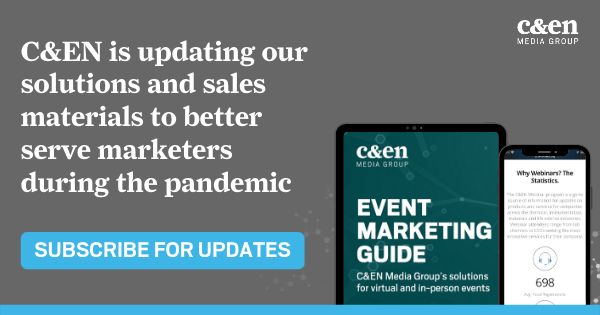Note: This blog post was originally published before COVID-19’s impact on event marketing, and has recently been updated with additional resources and virtual booth tips.
Setting up a conference booth once required flights, hotel stays, long days, confusing podium builds, printing mishaps, and a significant chunk of time away from all other business commitments. Now, all of the benefits of a physical booth can be achieved without changing out of your pajamas. We’ve entered a wonderful new age: the age of virtual symposia.
Naturally, there is a learning curve as we all adapt to increased interest in this forum. Attending virtual symposia and hosting virtual booths requires a different marketing strategy. However, proactively honing your skills will provide a marketing edge for your company.
So what goes into a winning approach?

1 – Establishing goals
Before any plans are put in place, coordinate as a team exactly what you are trying to achieve. It’s the same principle as for a physical event. Is the goal to launch a new laboratory instrument? Establish your presence and brand in the chromatography space?
Next, flesh out the details that can help deliver on these goals. What sort of content will you need? Close logistical coordination with the host will still apply, whether it’s a vendor, or your own IT team, but the implementation of a virtual event is twice as fast.
2 – Aesthetics
Take the time to create a visually appealing booth. It may not be a skillset your team has traditionally called upon, but good procedures are worth getting in place.
How do you do that in a virtual environment?
Think colorful, high contrast, and high impact. Work with the vendor to determine the best way to grab browsers’ attention. Your messaging and designs should always be tailored to fit within the designated display areas, but don’t forget to ask about the ‘add-ons’: additional promotional opportunities both inside and outside your booth. This can be anything from banners in the ‘lobby’ to pre-event email blasts, intended to make your participation even more personal and memorable. Consider leveraging these to ensure attendees that don’t enter your booth still get a feel for your company’s brand and specialty. And make sure your logo is in a prominent place!
3 – Preparing content
With a virtual event, there are fewer limitations to the quantity and quality of the content you can provide. Extended videos are just a click away for any virtual visitor. That said, you’re not just competing with other booths, but with an attendee’s day-to-day workload as well, and if you lose their attention for a moment, attendees can slip away. As such, a virtual booth does not mean you can scale back on the value proposition, but quite the opposite: content needs to be clearer and stronger than anywhere else.
Pre-record snappy videos and minimize the possibility for technical errors by checking your links and files several times over. Ensure the content is original – it’s worth the investment – and includes a mix of products and service-specific content, along with your company’s stance on broader issues, if applicable. This will drive good discussion and thought leadership.
As with physical conferences, get the ball rolling on content development as early as possible. You may save a day or two by not having to print materials, but the time crunch will be eerily familiar as symposium day approaches. Also keep in mind that you can build content to distribute after the symposium is over, which is one of the appeals of participating in this type of conference. Ideally, you’ll also be looped in with the many great contacts you’ve gained, and you should think about a post-event marketing and content strategy for the leads you’ve captured during the show.
4 – Hosting a social booth
People will stay longer and engage more if attendees communicate with each other at your booth. Use the private chat feature made available by the host. Using the event hashtag invites people to join your conversation and makes it easy for attendees to gather each other’s contact details for networking after the show.
In some ways operating online is tougher: you can’t lure guests in with the smell of freshly baked cookies or coffee. But with virtual symposia, you can challenge the limits of time and space. Games and quizzes – the traditional conference tactics – are a friendly way to draw attendees in, but how about starting competitions well before the event begins? Rally potential attendees on social media, encouraging them to follow your Facebook or LinkedIn page. Offer anything from random prizes to advanced gamification. It could be a science-related challenge; it might be about new ways to network in the current environment – be imaginative. Provide your audience with a running start and they’ll be much more engaged with your conversations throughout your campaign. With a virtual event, it’s also an easy initiation: all they have to do is log in!
Whether or not you implement prizes, feedback and communication from your guests is vital. Invite guests to share occupational pain points, a positive experience with your products or services, or comments for how participants would like to see the industry grow and respond to challenges. Attendees that have engaged will be looping back in to check buzz around your booth.
5 – Conscripting an A-team
As science marketers we experience additional hurdles when it comes to winning over crowds, digital ones included. The field we operate in is technical and often niche. Plus, scientists are trained skeptics.
Meet these challenges head on with your company’s own experts. Beyond product and service leaders, you should recruit representatives from many different divisions. Engineers for example, may not be able to explain the terms and conditions of a deal to the extent that a sales rep could, but each role has valuable input.
To respect everybody’s time, build a roster that designates specific shifts to man your virtual booth. This will ensure your visitors’ needs are met and that the discussions stay fresh. With the flexibility to work from anywhere, you can even encourage company executives to log in for cameos.
Want more tips? Download the white paper on virtual events, now with additional information on lead generation programs.
6 – Practice patience on the day
Invite guests to enter your booth, browse and explore. Just don’t harass them immediately. We’ve all experienced needy shop assistants in brick and mortar stores; let’s not carry that practice over to the virtual world.
Patience is not to be confused with passiveness. Have pre-determined leading lines ready, e.g. “ask us about our latest chemical innovation.” These skills should transfer over from in-person events. Calls to action remain the best closing line, in writing and via live chats. Have a destination, such as a purpose-built landing page, to send your warm leads.
7 – Follow up
One final point to underscore is to ensure no lead falls through. To coach them through the sales funnel, provide something of value to the customers. If your team engages with an attendee one-on-one, think about how you can build a customized solution for his or her needs. (We covered this most recently in our Lead Generation Campaign Checklist.)
If the virtualization of conferences has taught us anything, it’s that change is always in the pipelines. Keep up-skilling; don’t rely on what worked last year. Make sure that your supporting technologies are similarly progressive. You have an opportunity to innovate and to propel your company forward.




















